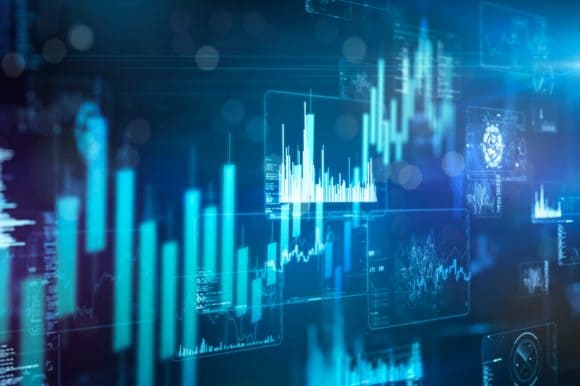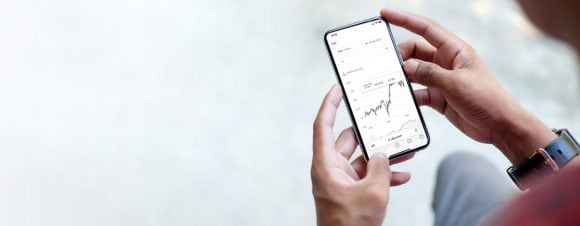An ETF is a basket of securities that can be bought or sold on a stock exchange. It holds multiple underlying assets. ETFs can contain many types of investments, such as stocks, bonds or commodities. What does ETF stand for? They are called Exchange Traded Funds because they are traded on an exchange just like stocks are. The price of an ETF’s shares will change throughout the trading day as the shares are bought and sold on the market.
What does investing in ETF mean?
Investing in ETFs means investing in a whole market like a distinct equity, bond or commodity market. Typically, ETFs track a particular index, for example the MSCI World Equity Index as a proxy for global equities, the S&P 500 Equity Index that covers stocks of the biggest companies in the US, or the Bloomberg Global Aggregate Bond Index, which represents the global bond market.
An ETF can own hundreds of securities across various industries, or it can be dedicated to one particular industry or sector, like the technology sector. ETFs can also track markets in certain regions like Asia, Europe or the US, and they can even be structured to track specific investment strategies.

Types of ETFs
ETFs are launched and managed by companies in the financial services sector. Various types of ETFs are available to investors that can be used for income generation, capital growth or to mitigate risk in a portfolio. Here is a brief description of some of the types of ETFs that are available today:
Equity ETFs
Stock (equity) ETFs comprise a basket of stocks to track the equity market of a certain region or sector.
- For example, an ETF might track the MSCI Europe Equity Index, providing exposure to this market.
Bond ETFs
Provide regular income to investors. Their income distribution depends on the performance of underlying bonds.
- They might include government bonds or corporate bonds. They don't have a maturity date.
Sector ETFs
They focus on a specific sector or industry. Also used to rotate in and out of sectors during economic cycles.
- For example, an energy sector ETF will include companies operating in that sector.
Commodity ETFs
Invest in commodities, including crude oil or gold. Diversify a portfolio, making it easier to hedge downturns.
- For example, commodity ETFs can provide a cushion during a downturn in the stock market.
Currency ETFs
They track the performance of currency pairs, consisting of domestic and foreign currencies.
- To speculate on the prices of currencies based on political and economic developments of a country.
Inverse ETFs
They attempt to earn gains from stock declines by shorting stocks. They are bets that the market will decline.
- Shorting is selling a stock, expecting a decline in value, and repurchasing it at a lower price
Leveraged ETFs
A leveraged ETF seeks to return some multiples like 2x or 3x on the return of the underlying investments.
- For instance, if the MSCI Europe Index rises 1%, a 2x leveraged MSCI Europe ETF will return 2%
How do ETFs work?
The goal of each ETF is to replicate its index as closely and cost-effectively as possible. Also, the investor receives all income from the securities in the underlying index. Therefore, investors participate in dividends and interest payments with ETFs.
ETFs vs Mutual Funds: all the differences
ETFs are considered different to mutual funds, which normally are not traded on an exchange, and which trade only once per day after the markets close.
ETFs are offered on multiple asset classes from traditional investments to so-called alternative assets like commodities or currencies. Additionally, ETFs tend to be more cost-effective and more liquid compared to mutual funds. ETFs are part of Exchange Traded Products ETPs.
What are the benefits and advantages of ETFs?
Easy to trade
ETFs can be bought and sold via any cost-effective online broker that deals in shares.
Very liquid
ETFs can be traded whenever you like during normal market hours, unlike traditional funds that can only be traded once a day.
Low costs
Running costs are low compared to active funds
Simple to understand
Investing in individual company shares is best left to the professionals, but even active funds can require a lot of research – and you're still never sure how the manager is running your money. In contrast, ETFs aim to match an index, which makes them straightforward investments.
Wide selection
There are more than 8500 ETFs listed worldwide, allowing exposure to most countries, regions, sectors, and asset classes.
Diversification
Buying an ETF provides instant exposure to the index it follows, which may contain dozens, hundreds, or even thousands of securities. It’s an efficient way to get a well-diversified exposure to different asset classes.
Income generator
There are many ETFs that pay dividends from their holdings of shares, bonds, or property, and thus provide some income. Lower costs mean more income for the investor.
Priced close to assets
The price of most ETFs closely reflects the value of the assets they hold. This is in contrast to some products like investment trusts for example – where the trust's shares frequently trade at a premium or a discount to their assets, which means additional risk.
Easy to find
As there is often more than one ETF on an index, they are easy to compare. Online, investors can find all the data they need, so they can compare the cost, risk, and return characteristics of different ETFs.
What are the risks of ETFs?
Trading Risks
The mindset can change from investor to active trader. Once investors start trying to time the market or pick the next hot sector, regular trading adds costs to the portfolio thus eliminating one of the benefits of ETFs, low fees.
Portfolio Risks
ETFs are often used to diversify passive portfolio strategies, but this is not always the case. There are many types of risks that come with any portfolio, from market risk to political risk to business risk. With the wide availability of specialty ETFs, it's easy to increase the risk across all areas and thus increase the overall risk of a portfolio.
Tracking Error
The difference between the returns of the ETF and the target index is known as the tracking error. Most of the time, the tracking error is very small, normally below one percent. However, a variety of factors can sometimes lead to a gap of several percentage points between the ETF and its target index. In order to avoid this, index investors should understand how these gaps may develop.



